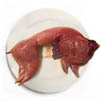Vanitas – 2006
The Chinese proverb “Eat Drink Man Woman“, used by Ang Lee as a title for his film in 1994, reminds us that, beyond all our culture and civilisation, however sophisticated, lies the fact of our animality. Before we are spiritual beings, we are physical ones, before the mind comes the body.
Artists have long reflected this, particularly in two traditions of the Western painting tradition: the still life and the memento mori or vanity painting. Still lives, whether of kitchen tables groaning under the weight of game after a hunt or of simple arrangements of fruit or bread, celebrate the life of the body and sensual pleasure in eating. Depictions of Vanity, in which the veil of earthly beauty is cruelly torn aside to show the skeleton beneath, acknowledge the darker side of being an animal body. In the words of Leonard Cohen, asked for his view on life, “Ends badly“.
The medieval Christianity in which the vanity painting has its roots emphasised the next world over this and dismissed the value of earthly pleasure. The rise of the modern world changed the emphasis, both by downgrading the significance of religion as the only lens through which we could see our lives and by creating a culture in which the enjoyment of the pleasures of the flesh became an activity encouraged and applauded. In the depictions by impressionists and pointillistes of the French bourgeoisie at pleasure, picnicking, dining on boats or in restaurants, exchanging glances of flirtation and seduction we see the democratisation of sensuality. No longer the preserve of the wealthy or restricted to a few festival days, the enjoyment of the world becomes the right to the pursuit of happiness by all (as claimed in the American Declaration of Independence).
John Yeadon’s Vanitas synthesises these traditions, celebrating the mortality of the eater and the eaten. In this bold acceptance of both desire and doom, of Eros and Thanatos, we find ourselves acknowledging that we share life with the things we eat – and we share death with them too. The first Western art works – the cave paintings – show hunters and hunted – the eater and the eaten – in shamanistic identification. In this exhibition we can find some of that consolation.
Will Barton, November 2006

